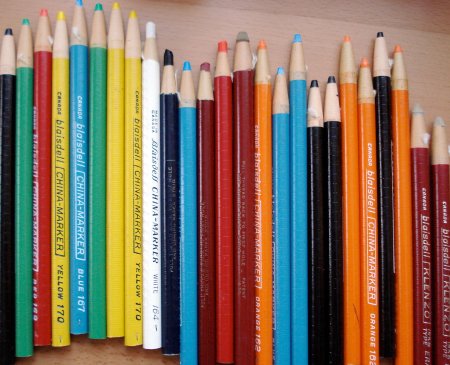
Does anyone remember these? Or still use them?

Known as grease markers or china markers, these pencils have wax colour cores, and are wrapped in paper that one tears off link by link. I remember these always being around the house when I was growing up, yet can’t recall what they were used for.
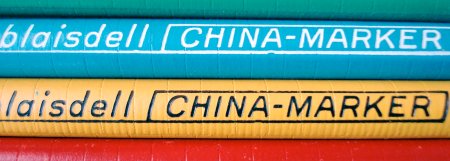
Still manufactured, I’ve seen them used for traditional purposes such as marking glass and ceramics, but also for more modern tasks such as marking laminated calendars and restaurant seating plans.
These particular ones date from perhaps the 1980s, and are branded Blaisdell. The box says they were made by Eagle/North-Rite, a division of Berol of Canada. All these long gone names!
This article from Stanford credits Blaisdell with inventing this format of grease pencil.
Also shown is a cousin, the Klenzo Ink & Type eraser.

To reveal more lead, one pulls the string, breaking the top layer of the coloured paper. Then, the paper is uncoiled. A simple solution that works well! I think it would be very interesting if the paper had fortunes or small quotations printed on the coils, but that might be a bit distracting.
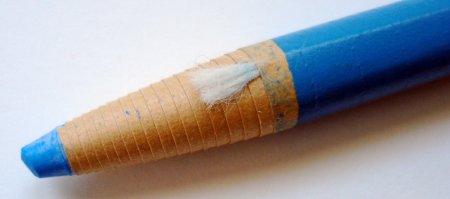
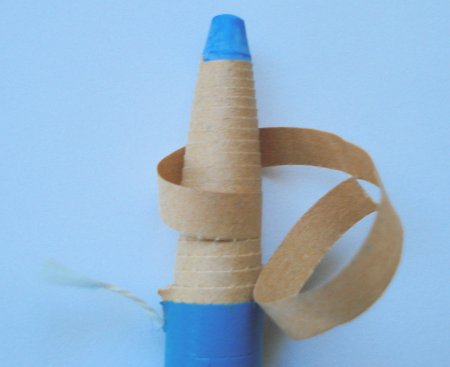
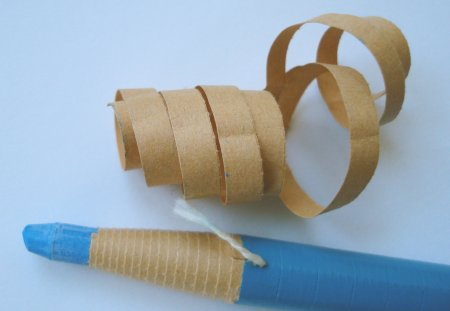
They come in bright colours, no subtle forest shades here!


I use lithographic crayons for printmaking which are identical to what we used to call china markers, with the string and the peel-off-in-strips paper wound around. I inevitably find the string gets in the way when I draw.
I know people who use china markers for marking up print proofs. I used to myself, but now have ended up with Sharpies . . .
Huh ! Learn something everyday. I used to use Chinagraph pencils and still have a few, but they were ordinary woodcase pencils. I have never seen or heard of these paper wrapped versions before. Or are chinagraph something different?
Thank you for the comments.
Kiwi-d, when I search for chinagraph pencils in a search engine, what turns up are specialty all-surface marking pencils from Stabilo and Staedtler. And I see that Staedtler Australia makes a specific brand called “Chinagraph”. I do have some Stabilo All woodcase marking pencils, and would say they are not the same thing. These have distinctively soft and brightly pigmented wax cores, as well as a much different housing.
I’m also taking a small liberty in calling these “pencils” – I think they clearly are, and the paper wrapping technique is mentioned in Petroski’s The Pencil, but they seem to be called “markers” in most usage.
I have a paper-wrapped pencil we purchased a couple of years ago at, I think, The Container Store. It’s a “Scratch Be Gone” pencil, made for repairing scratched CDs and DVDs. It seems to be a standard grease pencil (at least I think that’s what they’re called), repurposed for a modern use.
I remember my Uncle in the US-Army in the 70ties in Germany used china markers for tactical sketching on maps, which where covered with a transparent foil or even foil-claded. When I stayed with him during holidays I sometimes was allowed to clean the maps with a sort of methylated spirit, which made me feel very serious;-) I think this was at that time still quite common, because like a pencil this works also under bad weather conditions.
When he returned to the US he left behind a box full of china markers (I’m German) and I have still some I use for markings, especially on glass or other very smooth surfaces. Unfortunately the Ticonderogas in the box are gone.
Hello Frank, thank you for your comment. Your recollections bring to mind the interesting Landkartenstift.
Thank you :-) After a long and unsuccessful search for the origin and the use of these “map pencils” in connection with cartography I have heard that they were probably used by pilots in WWII. Maps were expensive at that time so removable pencils were very useful. A few weeks ago someone whose brother is an airline pilot told me that it is still common practice to place removable marks on aeronautical charts but today they use post-it arrows (which is especially interesting in view of the high tech unsed in aviation). I don’t have any proof for this information but at least I can restart sleuthing.
Thanks Penciladmin. The chinagraph I’m familiar with seem to serve the same purpose as these pencils – removable marks on maps, plans, etc. As kids we used them for marking game counters. “Wooden Ships & Iron Men”.
The were generally only available in blue, but I know green and maybe red and some other colours existed.
I’ve never seen or heard of these paper wraps. I guess they never made it down here. Certainly the range of colours is vast compared to chinagraph.
Yes! I loved these…my dad had a bunch in black, red, blue, etc. I always liked removing the paper.
I had an algebra teacher in high school (this would have been mid-80s), who, instead of using a chalk board, used an overhead projector on which she wrote directly with a china pencil. She kept a squirt bottle of rubbing alcohol nearby to clean off the … uh, whatever you call the flat part of an overhead projector. This way she didn’t have to use transparencies.
The life drawing artist’s best friend!
I still have a handful of these, mostly lighter colors – white and yellow. They were very handy for marking negatives and such in the darkroom. Can’t say I’ve used one of them in many years, so they sit in a case with the typewriter white-out and a few old wax sticks from manual page layout.
Does the Blaisdell Layout Pencil belong to this same family of grease/china markers or does it have a graphite core? Picture here:
http://farm1.static.flickr.com/84/217237929_f8ca4d1c04_o.jpg
Poking around the web it appears that the Blaisdell Layout Pencil has the same talismanic hold on animators, and is every bit as rare, as the legendary Blackwing 602. Jenny Lerew the artisit and blogger behind The Blackwing Diaries praises its “wide smear of soft lead”. Elsewhere in articles about Glen Keane the Disney animator, references to the core of this pencil explicitly refer to “graphite”, but Lerew’s characterization of the lead and the fact that it appears to be paper-wrapped like the regular Blaisdell china markers pictured in the OP leave me wondering what actually is the consistency of this magical substance. Anybody know?
Me! Me! I use them. The work really well for drawing on black paper – like this: http://www.flickr.com/photos/biffybeans/427706491/
Hi – I remember these pencils from way back – well the late 1970s onwards anyway.
The first one I saw was when my mum got a brand new chest /trunk freezer in the late 1970s accompanied with a frozen food recipe book, a selection of suitable foil and plastic containers to be used for freezing and a set of three coloured china graph pencils/markers: red/green/black The ‘grease’ in these markers was ideal for writing on the lids of plastic containers that could withstand the rigours of a deep freeze without smudging or being obliterated – handy when you consider that frozen foods could be kept for up to 4 months plus.
Then, when I was in secondary school working through my 4th/5th year option subjects studying Typewriting and Office Practice these paper wrapped pencils were a type of eraser. There was a choice of two types: the paper wrap and pull string version and the standard eraser pencil with a fan shaped brush on the tip to brush away rubber pieces from inside the manual typewriters (this was before the days of Tipp-Ex/WhiteOut).
I also remember going on a school visit to the local newspaper office and seeing the proof-sheets of photographs printed in black & white being marked with a generous circle of yellow china graph pencil – could have been something to do with Kodak?
Lynn (UK)
I always used grease pencils for marking up film for splicing (long time ago) and they were also used in video editing, as well as marking up contact sheets.
In my question above I’ve probably confused terms. I am asking whether the core of the Layout pencil uses the same kind of binder as Blaisdell’s other paper wrapped pencils. I am assuming two things, that the cores of the Blaisdell pencils in Stephen’s photos have oil in their formulation and that the Layout pencil, if it is the exception, may be wax-based or use some other substance still.
Similar in design to the grease pencil in that they are both paper wrapped, the core of the Blaisdell Layout pencil is indeed graphite. The layout is not the exception however, as Blaisdell made at least one other pencil that was paper wrapped graphite. I have a few myself. Having gone to school for animation I’ve spent quite a bit of time looking for both the Blaisdell layout and the Blackwing and I will say both are a pleasure to draw with.
I wish both of those pencils would be put back into production.
Patrick, thanks for answering my question. Given the unavailability of the Blackwing and the Blaisdell, have you discovered a satisfactory substitute?
No, not really. Everything I’ve ever heard recommended to replace the Blackwing always falls short somewhere in terms of lead and in terms of design, nothing today comes close. There are leads with similar qualities here and there but nothing compares as a whole.
I don’t think you’d want to write with the Blaisdell layout, the lead is very thick, although to each his own. For drawing though you can make some really bold (for lack of a better word) strokes with it. It’s a substantial pencil.
The other Blaisdell pencil which is paper wrapped and has a graphite core has a thinner lead. It’s more consistent in diameter with the grease pencils they put out. If you want I could try to take a picture of the leads for comparison and email them to you.
Patrick, thank you for your offer, that is most generous. But if you’re going to go to all that trouble, why not email the pics to Stephen so that everybody at Pencil Talk might get a chance to see them sometime in the future. Thanks to you I know that if I come across any kind of paper-wrapped Blaisdell pencil I should determine if it is graphite with a wide or narrow core, which knowledge is invaluable and sufficient for my purposes (mostly collecting). Without trying to obligate Stephen in any way, Pencil Talk can do far more good with this knowledge than a pencil gnome like myself because he can give it the context it so richly deserves.
Since the Art Institute I go to can’t give away cintiq’s we still use launch boxes and 12X animation bond, so ChinaMarkers are still the peferred instrument because it’s hard to get the camera to capture anything that isn’t as bold…I however find that the Aquarelle Aquamonoliths ™ are a great substitute to these as they also are very bold or dark, they don’t shmudge, but they’re easier to sharpen and are slightly erasable! They do wear away much quicker though because of them being smaller than normal…
Grease pencils are still very much in use in theatre and film lighting. They are used to write the identification number of the color filters that are placed in lighting instruments to alter their color
I used to work at a coffee shop, and we’d mark the time of preparation on the batches of coffee (great big multi-gallon thermos thingies) so we could remember to make new ones every hour or so.
I’ve also worked in a locomotive factory, and the welders would use them to mark metal parts for welding/painting/etc. Would then come off in the chemical wash.
I used to “borrow” them from work – terribly handy.
Ahh – paper-wrapped grease pencils…
I don’t know if they still do things this way in the Navy, but I suspect they might. If you’ve ever watched some old Navy war movies, you might have seen guys standing behind clear plastic boards plotting out the movement of ships or planes on the reverse side. They had to learn how to write backwards.
I did the same thing to a lesser extent in the late 70’s-early 80’s while in the Navy, plotting out the location of shore-based radars against map outlines. We used a color-coded scheme for the info so had several different colors in use.
The boards are plexiglas, edge lit, so anything written on them sort of glows from the light but the surface itself remains transparent/dark. (Of course, this works quite well in a dark environment like the combat center on a ship.) You might have seen displays like this in some restaurants. You write on the back so that you’re not in the way of people trying to see what’s being written and/or so people passing by won’t accidentally wipe the writing off.
I have come into ownership of three boxes of Blaisdell nick-n-pull pencils, cousins of the china markers. The difference is, these are crayons, they are erasable, smudgable, absolutely lovely for drawing, and were made in many colors. I have black, red and blue. An old office-supply store had several boxes of them. They are oil based, I believe. The china markers are no different from Sanford’s and are not erasable.
I also acquired a virgin Blackwing pencil! and a Venus copying pencil and one other.
On another note, I am happily using my new Mongol pencils, acquired through pencilthings.com, and they are wonderful.
I use the yellow as a dry highlighter.
I remember them from my childhood (the 70s) when the shop next door to my father’s Chinese herbal shop used them to put prices directly on glass and ceramic products.
about a hundred thousand years ago > we used to use grease-pencils at cbc radio to mark reel-to-real audio tape for editing > splicing which was done with actual razor blades > in an editing block (with several diagonal and one vertical chop guide) > taped back together with editing tape > which was the same width as the audio tape and less adhesive than scotch tape (which would work in a pinch) > this allowed for edits to be undone and re-done > computers are used now > and it’s at least eleven thousand times better
I’ve always wondered how these were used on china/glass. We always just used the the yellow or flourescent colored (my favorite was the neon green) Dermatographs as a cheap highlighter. In one art class we used the white to draw on black.
The pull-and-unpeel mechanism is the best part!
Oh and in a pinch they make great markers to trace sewing patterns on cloth.
We used those ones around the chemistry lab to mark our materials. Most of my lab notes were also written with those (therefore I used like 5 times more paper than the other people)
This paper wrapping design was brought into Australia for Charcoal pencils. Just the same, the charcoal is wrapped by paper and can be revealed layer by layer. I have really enjoyed using them for fine details (snapping the charcoal as I went) because bare, handheld charcoal would blunten too quickly.
We (USAF)used them in Thailand in the 70’s (kind of like the above Navy guy) on our UPA35 radar scopes to track traversing aircraft, making a mark at each radar sweep. The scope screens worked like the side lit plotting boards. Our grease pencils were mechanical twist lead holders with about 2 inches of 1/8 th inch “lead.”
I’m looking for the Blaisdell Hard 634 T pencil. Please email me at pikesters1984@yahoo.com if you know where I can obtain as many of these as possible.
Does anyone happen to know what the Klenzo is used for?
I use China Markers when doing woodwork in places with a single light source (like my garage). If I were to use a normal carpenters’ pencil, the graphite would blend in with the wood and become hard to see at certain angles. No such problems with the China Markers. They also have the added benefit of not indenting the wood if I need to write somewhere that will be part of the finished product.
im in desperate need of these pencils
where can i get them
You may be surprised to know that these pencils are used widely throughout the Power Generation Industry by NDT inspectors. These are used for marking defect indications after spraying paraffin based magnetic inks or dyes for the detection of surface cracks. Just bought some Papermate ones.
i have the the Klenzo Ink & Type eraser pictured at the top of this page…but how do i use it?
it is like gritty sandpaper, very tough and it rips paper or smudges ink….how and what is the purpose of this type of pencil?
I use a china-marker / grease marker for marking glass /beakers in the laboratory…makes all the other students jealous lol…they have to remember what they put in their beakers (not too good when its HCl acid or strong base :O )
Hello Kitty,
The Ink & Type eraser is probably decades old. When new, it would have been like other ink erasers – rough, abrading, but useful in some circumstances.
I remember these paper-wrapped pens and I also remember I had a paper-wrapped pink eraser as well. Don’t remember the name though, and I used to cute the string shorter each time so that it didn’t get in the way! :)
Sanford Sharpie Blaisdell Papermate – China wax marker pencil – stock item. Ship worldwide
Looking for White & Yellow Grease pencils for marking in Broadcast editing. Can you please advise models, types & costs for our resale into Government & corporate sales.
Thank you.
I’ll pay $50 per pencil for Blaisdell Charoal Hard 634-T paper pencils. I’ll also pay a fat finder fee to whoever connects me to a seller. My email is pikesters1984@yahoo.com and my phone number is 208-413-1324.
Thanks,
Jim
REMEMBER THE OLD PROPELLING CHINAGRAPH, I HAVE 3 BLACK, A BLUE 2 WHITE A RED A BROWN AND A YELLOS
I AM DOWN TO LAST 3 BLACK REFILL LEADS, AND 1/2 OF WHITE LEAD LEFT.
ANYONE KNOW WHERE I CAN PURCHASE COME BOXES,
USED TO WRITE ON RADAR DISPLAYS, WINDOWS, PLASTIC CARD ETC.
WIPED OFF WITH SPIT. LOL AND TISSUE PAPER
VERY MANY THANKS
DESPERATE
can I buy empty pencil sleeves
Hello Sir
My name is Derrick Palmer and would like to place an order of ( Pencils ) Please send me a price list of the sizes you have and also advise if you accept credit card payment.
Regard,
Palmer
I have a fond memory of this pencils from elementary school in the 1970s. My teachers used them to correct our papers. They mostly used the red or black ones. All the kids would loved to go up to the teachers desk to try to get one. Things like this then were rare and not something most kids would have at home.